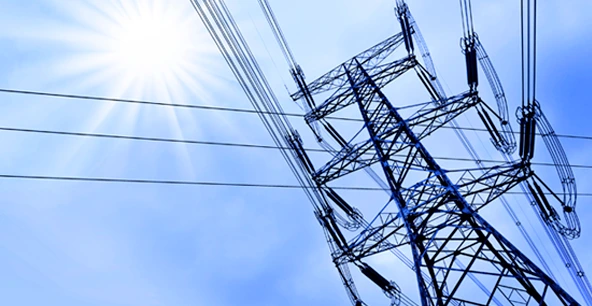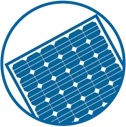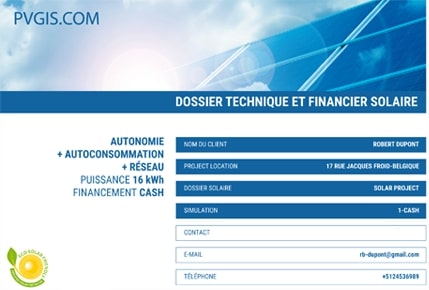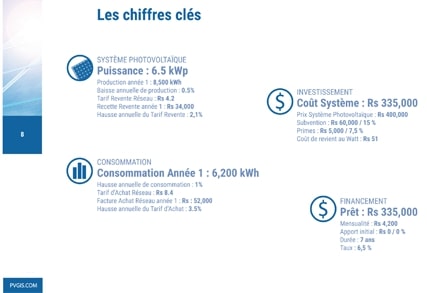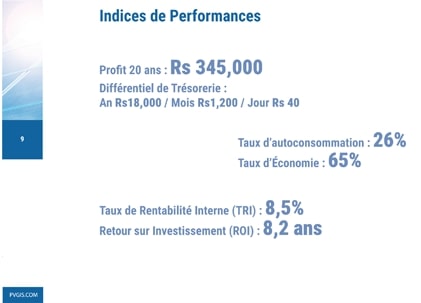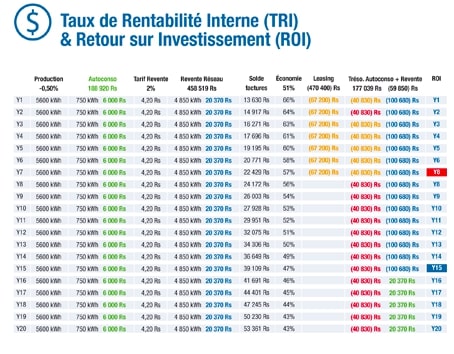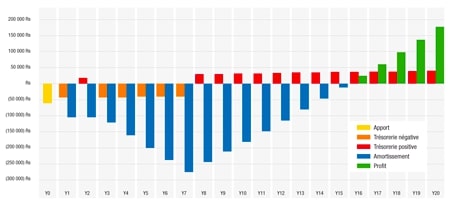SUBSCRIPTION AND USER MANUAL PVGIS24
1. My Subscription
This section provides an overview of your current subscription and allows you to manage and adjust your
PVGIS24
subscription according to your needs.
This section allows you to view all the details of your current subscription on PVGIS24. You will find
information about the subscription type, included features, available credits, management options, and billing
details.
-
1. Subscription Type and Renewal
-
Subscription:
Displays the current subscription level and the corresponding monthly rate.
-
Renewal Date:
Indicates the next automatic renewal date of the subscription. You have the option to cancel
at any time
before this date to stop future payments.
-
2. Features of Your Subscription
-
Authorized Users:
Number of user accounts included in your subscription.
-
File Credits:
Number of file credits available per month to perform simulations. Credits are used to
generate solar and
financial simulations.
-
Unlimited Simulations and Features:
The subscription includes unlimited solar and financial simulations per file, as well as
unlimited access to
PVGIS24 features for production and printing.
-
File Management and Storage:
Access the management of your files, with the ability to save all simulations and reports.
-
Technical Support and Commercial Use:
Enjoy online support and the right to commercial use of the results, with an ad-free
experience.
-
3. Payment Options and Billing
-
Current payment method: Details the payment method used for the
subscription,
such as your credit card, with the option to update your information if needed.
-
My invoices: View the history of your monthly payments, including
dates,
subscription type, and invoice amounts.
2. Change my subscription
You can switch to another plan by selecting an option better suited to your needs from the available
subscriptions (PRIME, PREMIUM, PRO, EXPERT). If you upgrade to a higher plan mid-month, only the
difference in
price will be charged, and we will credit the difference in File Credits. If downgrading, the change
will take
effect on the next renewal date.
3. PVGIS24 Calculator Subscription
An affordable subscription for €3.90 per month, suitable for users with limited needs for advanced
production
simulations.
4. Additional File Credits
Options to add extra credits to your subscription, at €10 for 10 file credits per month.
5. My PV Systems Catalog: Catalog and Organize Your Solar
Systems
This catalog helps you organize and view your solar systems based on their characteristics and
objectives,
making it easier to present to clients and select solutions suited to their energy needs.
In the "My PV
Systems Catalog" section, you can reference and describe all your solar systems, organizing each system by
category for clearer and more efficient management. This catalog allows you to create a structured inventory of
your photovoltaic solutions based on their characteristics and main applications.
-
1. Reference and Describe Each System
You can detail each solar system, including key information such as designation, PV power,
battery power,
and price. This description facilitates the management and consultation of your photovoltaic
solutions.
-
2. Categorization
Systems can be classified into the following categories for quicker, more tailored searches based
on your
clients' specific needs:
-
Resale: Systems designed for selling energy to the public grid.
-
Self-consumption: Systems intended for self-consumption, for users
wishing to
consume the energy produced on-site.
-
Autonomy: Systems equipped for energy independence with batteries
for energy
storage.
-
3. Key Information for Each System
-
Designation: Name or description of the system for quick
identification.
-
Price: Indicates the total cost of the system for immediate budget
consultation.
-
PV Power (kW): Enter the photovoltaic power to assess energy
production
capacity.
-
Battery Power: Enter the capacity of the batteries for autonomy or
self-consumption systems with storage.
6. Default Settings: Editable Reference Information
Default settings are flexible and adaptable base values. Feel free to customize them in each file and
adjust
them during simulations to obtain optimal estimates tailored to your specific projects. Default settings
are
predefined base parameters that serve as a reference to facilitate simulations and solar production
estimates.
These default values are automatically applied in each file, but they can be adjusted to better fit the
specifics
of each project.
-
1. Editable Base Settings
-
Default settings include standard values for costs, interest rates, loss percentages,
maintenance fees,
and other reference data. They are designed to provide a realistic and simplified base for
your initial
simulations.
-
2. Customization for Each File
-
You can modify these settings for each individual project to better reflect the specific
conditions of
each installation or particular requirements of your clients. This allows you to tailor the
simulations to
the unique aspects of each project.
-
3. Modification During Simulations
-
During the simulation, you have the option to adjust the settings based on the needs or
scenarios you
wish to explore. These modifications allow for more accurate and realistic results for each
simulation.
7. Residential Consumption Information
Base for Solar Self-Consumption Simulations
This section provides an essential foundation for simulating your solar self-consumption project with
precision
and maximizing your energy autonomy gains. The "Residential Consumption Information" section provides
key data for
simulating solar production for self-consumption with PVGIS. By entering your consumption habits (split
by day,
evening, and night, weekdays and weekends), you will get an accurate estimate of your electricity
consumption,
which will serve as a reference for:
-
1. Adapt solar production to your needs:
Consumption data
helps simulate the most suitable solar installation to cover your energy needs when you need it the
most.
-
2. Optimize self-consumption:
By understanding your peak
consumption periods, PVGIS can estimate how much of your solar production will be used directly, thus reducing
your dependence on the public grid.
-
3. Forecast potential savings:
By comparing estimated solar
production with your residential consumption, PVGIS calculates the percentage of energy you can self-consume,
providing an estimate of savings on your electricity bill.
8. Commercial Consumption Information
Base for Solar Self-Consumption Simulations
This section is essential for commercial solar simulations as it helps tailor solar production to the
specific
needs of the business, promoting better energy autonomy and reducing operational costs.
The "Commercial
Consumption Information" section provides crucial data for performing solar self-consumption simulations adapted
to business needs. By entering your electricity consumption habits (split by time of day on weekdays and
weekends), this data serves as a reference for:
-
1. Adapt solar production to business hours:
Consumption
data helps simulate a solar installation that precisely matches the times when your business needs the most
energy, maximizing the use of the solar energy produced.
-
2. Optimize the self-consumption rate:
Based on your
consumption peaks, PVGIS estimates the proportion of solar production that will be directly consumed, reducing
electricity costs from the grid.
-
3. Forecast savings and return on investment:
By comparing
solar production with your energy needs, PVGIS calculates the potential for self-consumption and estimates the
savings you can achieve on your electricity bills, providing a key indicator to evaluate the project's
profitability.
9. Recommended Losses by Default for a Solar System
These recommended default losses help to provide an estimate that takes into account the practical
limitations
of your solar system, ensuring a more accurate production forecast.
Solar production simulations incorporate
estimated losses to provide a realistic prediction of usable energy. These losses are default recommended
percentages based on the average performance of solar installations. Here are the default losses typically
recommended for each component and their impact:
-
1. Cable Losses (1-2%):
-
Cable losses are inevitable since the electricity produced by the panels must be transported
to the
inverter and then to the grid or consumption meter.
-
Generally, an estimate of 1 to 2% cable losses is recommended.
This percentage
depends on the length and gauge of the cables: longer or smaller
cables result in
higher losses.
-
Using high-quality cables with an appropriate gauge can minimize these losses.
PVGIS24 estimates the cable loss by default at 1%.
-
2. Inverter Production Losses (2-4%):
-
The inverter converts the DC power produced by the solar panels into usable AC power. This
process is not
perfect and leads to losses.
-
On average, inverter losses are estimated at 2-4%. High-quality modern inverters can reduce
these losses,
while less efficient equipment can increase them.
-
This percentage is based on the conversion efficiency of the inverter, which typically
ranges between 96%
and 98%.
PVGIS24 estimates the inverter production loss by
default at 2%.
-
3. Solar Panel Production Losses (0.5-1%)
-
The panels themselves experience efficiency losses due to external factors such as dirt,
partial shading,
high temperature, and the natural degradation of solar cells over time.
-
The performance of panels naturally declines over time (about 0.5% to 1% per year depending
on materials).
The performance loss is due to physical degradation, such as glass yellowing, corrosion, and
cracks in the
cells.
-
Regular maintenance, such as cleaning the panels and optimizing their placement (to limit
shading), can
reduce these losses.
PVGIS24 estimates the solar panel production loss by
default at 0.5%.
By using these default loss values, PVGIS gives you a reliable and realistic estimate of your solar
production.
These percentages are based on industry averages and help account for the gaps between theoretical and
actual
production, incorporating the physical variables that affect the performance of each component.
10. Maintenance Information
This maintenance information helps plan regular maintenance to maximize the photovoltaic system's
production and
reduce long-term costs. By keeping the system in good condition, you prevent performance losses and
ensure the
profitability of your solar investment.
The "Maintenance Information" section provides key details for planning and estimating the maintenance costs
of a photovoltaic system. Regular maintenance is essential for ensuring optimal performance and extending the
system's lifespan. Here are the maintenance elements considered in this section:
-
1. Annual maintenance of the photovoltaic system
(% of the total system cost):
-
This percentage indicates the share of annual maintenance costs relative to the system's
initial cost.
Generally, maintenance represents about 1 to 2% of the system's total cost per year.
-
This estimate covers necessary interventions to clean the panels, check the wiring and
inverter, and ensure
the system is working correctly.
-
Regular monitoring helps prevent performance losses related to dirt, wear, or component
degradation.
-
2. Maintenance cost per Watt
-
The cost per watt provides an estimate of the annual maintenance expenses based on the
installed power. This
value is useful for large installations, as it allows easy calculation of costs based on the
system's size.
-
By indicating this cost, you can obtain an accurate estimate of your annual maintenance
expenses,
proportionate to the size of the installation.
-
3. First maintenance period after commissioning
-
This information helps plan the first inspection or maintenance after installation.
Generally, the first
maintenance is recommended within 6 to 12 months of commissioning to ensure the system is
functioning
perfectly.
-
The first maintenance is important for detecting and correcting any early issues, such as
installation
defects, panel alignment, and inverter performance.
11. Financial Information: Public Grid Electricity Sale Rates
This information is essential to simulate your resale income and better understand the profitability of
your solar
project. By providing resale data, you get an estimate of your potential earnings, adjusted for caps and
rate
changes.
This section allows you to provide financial information related to the sale of electricity produced by your
solar system to the public grid. This data will help you estimate your potential income from selling your excess
energy.
-
1. Resale Rates (kWh) for Electricity Produced to the Public Grid
-
Enter the current rate at which you can sell each kilowatt-hour (kWh) of electricity
produced by your solar
installation. This rate is generally set by the authorities or your electricity provider.
-
2. Estimated Annual Increase in Resale Rate (kWh)
-
Enter the estimated percentage increase of the annual resale rate. The current global
average of 3.5% per
year helps estimate the evolution of your income over the long term.
-
3. OPTION: Production Caps for Full Resale Rate (kWh)
-
Some resale offers include a production cap, beyond which the resale rate is reduced. Enter
the number of
kilowatt-hours (kWh) you can sell at the full rate.
-
This cap allows you to optimize your revenue up to a certain annual production limit.
-
Resale Rates (kWh) for Electricity Produced to the Public Grid After Exceeding the Cap
-
Enter the rate applied for the resale of electricity beyond the production cap, if
applicable. This rate is
usually lower than the full rate and is applied once the production limit is reached.
12. Financial Information: Administrative Fees, Connection, and Installation Compliance
This information helps you take into account available subsidies and get an overview of your financing.
By
incorporating grants and aids, you can obtain a realistic estimate of the net costs and evaluate the
profitability
of your solar project.
This section allows you to provide information regarding state grants or subsidies that you may benefit from
when acquiring your photovoltaic system. These subsidies, often offered to encourage renewable energy, can
significantly improve the profitability of your project.
-
1. Estimated Administrative Fees for Public Grid
-
Enter the estimated amount for administrative fees required to obtain the necessary permits.
These fees may
include costs for file review, permits, and processing by local authorities or energy
regulatory agencies.
-
2. Estimated Connection Fees to the Public Grid
-
Enter the estimated costs to connect your solar installation to the public power grid. This
includes fees
related to the installation of connection equipment (meters, cables, etc.) and any necessary
work required
to link your system to the grid.
-
3. Estimated Compliance Fees for the Installation
-
Enter the estimated amount to ensure that your installation meets all current safety and
quality standards.
These fees include inspections, certifications, and tests necessary to ensure that the
installation complies
with local regulatory requirements.
13. Financial Information: State Grants and Subsidies
This information helps you take into account available subsidies and get an overview of your financing.
By
incorporating grants and aids, you can obtain a realistic estimate of the net costs and evaluate the
profitability
of your solar project.
This section allows you to provide information regarding state grants or subsidies that you may benefit from
when acquiring your photovoltaic system. These subsidies, often offered to encourage renewable energy, can
significantly improve the profitability of your project.
-
1. State Grant or Subsidy for the Acquisition of a Photovoltaic System
-
Enter the amount of the state grant or subsidy you are receiving to finance your
photovoltaic installation.
You can enter this amount as a percentage of the total system cost or as an absolute value
(in rupees).
-
These aids can reduce acquisition costs and improve the return on investment of your solar
installation.
-
2. Payment Period for the State Grant or Subsidy After Commissioning
-
Enter the number of months after the commissioning of the solar installation before
receiving the grant or
subsidy. This helps incorporate this delay into your financial forecasts.
-
3. Date of Payment for the State Grant or Subsidy
-
If you know the exact payment date for the grant or subsidy, enter it here. This helps align
financial
flows and better manage the project budget.
14. Financial Information: Tax Subsidy
This information helps you calculate the net cost of your solar installation after accounting for tax
subsidies,
improving the accuracy of your financial forecast and facilitating the evaluation of your project's
profitability.
This section allows you to provide details regarding tax subsidies you may receive for the installation of
your photovoltaic system. Tax subsidies are incentives offered by the government to encourage solar energy,
helping reduce the net cost of your investment.
-
1. Tax Subsidy for the Acquisition of a Photovoltaic System
-
Enter the amount of the tax subsidy you receive for the acquisition of your photovoltaic
system. You can
enter this amount as a percentage of the total installation cost or as an absolute value.
-
This subsidy reduces the acquisition cost, thus improving the overall profitability of your
solar project.
-
2. Payment Period for the Tax Subsidy After Commissioning (months)
-
Enter the number of months after the commissioning of your photovoltaic installation before
the tax
subsidy is paid. This helps incorporate the delay into your financial planning and
anticipate the
availability of funds.
-
3. Payment Date for the Tax Subsidy
-
If the date for the tax subsidy payment is set, enter it here. This allows you to
synchronize this payment
with your budget management and optimize your cash flow.
15. Financing Information: Cash Payment (CASH)
By providing this information, you get an overview of your cash financing capacity and payment terms,
helping you
plan your investment in your photovoltaic system with greater peace of mind.
This section allows you to enter information about personal contributions and payment facilities for financing
your photovoltaic system through a cash payment.
-
1. Minimum Contribution (%)
-
Enter the percentage of personal contribution you plan to invest in the installation. This
minimum
contribution represents the share of financing you are able to provide immediately, without
external
financing.
-
A higher personal contribution can reduce the need for loans and thus the associated
financial costs.
-
2. Payment Terms (months)
-
Enter the duration of the payment terms offered by the supplier or service provider to
complete the
financing. This number of months represents the period during which you can settle the
remaining amount,
often without interest.
-
Payment terms can help you better manage your cash flow and spread the cost of the
installation without
significantly impacting your personal finances.
16. Financing Information: Loan
By providing this information, you can estimate the total cost of your loan financing and calculate the
impact of
interest and fees on your solar energy investment.
This section allows you to enter details regarding the financing of your photovoltaic system through a bank
loan. By entering this information, you get a more accurate estimate of the costs associated with the loan and its
impact on the overall budget of your project.
-
1. Personal Contribution (%)
-
Enter the percentage of the total installation cost that you are financing with a personal
contribution.
This contribution is the portion of financing you provide yourself, without borrowing.
-
A higher personal contribution can reduce the loan amount needed, which may lower the
monthly payments and
interest fees.
-
2. Loan (%)
-
Enter the percentage of the total installation cost that you wish to finance through a loan.
This percentage
represents the portion financed by the bank loan.
-
By combining the personal contribution and loan amount, you get the total financing needed
for your solar
project.
-
3. Interest Rate (%)
-
Enter the annual interest rate applied to the loan. This rate determines the cost of the
financing based on
the loan duration and the borrowed amount.
-
A lower interest rate can reduce the total cost of the loan and improve the profitability of
your project.
-
4. Duration (months)
-
Enter the total loan repayment period in months. The loan duration influences the amount of
monthly payments
as well as the total interest paid.
-
A longer loan may reduce the monthly payments but generally increases the total interest
paid over the
period.
-
5. Bank Processing Fees
-
Enter any processing fees or other banking costs associated with taking out the loan. These
fees are often
charged at the beginning of the contract and should be included in the overall project
budget.
17. Financing Information: Leasing
By filling in this information, you will get an estimate of the costs of your leasing financing,
including monthly
rent, fees, and the buyout value. This helps you assess the profitability and accessibility of this
financing
option for your solar project.
This section allows you to enter details about financing your photovoltaic system through a leasing contract.
Leasing is a financing option that allows you to rent the equipment with an option to purchase at the end of the
contract, via a buyout value.
-
1. Initial Contribution (%)
-
Enter the percentage of the total installation cost that you are financing with an initial
contribution.
This contribution reduces the amount financed by the leasing and can lower the monthly
payments.
-
A larger personal contribution can make the leasing contract more affordable by reducing
financing costs.
-
2. Leasing Financing (%)
-
Enter the percentage of the total installation cost that you are financing through the
leasing contract.
This amount is financed by the leasing company and is repaid through monthly rents.
-
The personal contribution added to the leasing financing should match the total project
cost.
-
3. Interest Rate (%)
-
Enter the interest rate applied to the leasing. This rate determines the cost of the monthly
rents, based
on the duration of the contract and the amount financed.
-
A lower interest rate reduces the total cost of the leasing financing.
-
4. Duration (months)
-
Enter the total duration of the leasing contract in months. The contract duration influences
the rent
amount as well as the interest paid.
-
A longer contract may reduce the monthly rents but increases the total interest cost.
-
5. Banking Fees
-
Enter the application fees or other administrative costs associated with setting up the
leasing. These
fees are usually due at the beginning of the contract and should be included in the overall
project budget.
-
6. Buyout Value (%)
-
The buyout value is the amount to pay at the end of the leasing contract if you wish to own
the
photovoltaic system. Enter this value as a percentage of the initial cost or as a fixed
amount.
-
The buyout value allows you to transfer the ownership of the system at the end of the
contract. It should
be included in the total cost calculation if you plan to purchase the system at the end of
the leasing.
By filling in this information, you will get an estimate of the costs of your leasing financing,
including monthly
rent, fees, and the buyout value. This helps you assess the profitability and accessibility of this
financing
option for your solar project.

